On the island of Crete, which lies nearer to the coast of Africa than to the Greek mainland, a brilliant civilization flourished from approximately 3650 to 1400 BCE. It was rediscovered at the beginning of the 20th century through the work of British archaeologist Arthur Evans and refers to the mythic King Minos. Minos was associated in Greek myth with the labyrinth and the Minotaur, which Evans placed at the largest Minoan site, Knossos.
The Minoans were the first Europeans to have a literate civilization. They were traders who built a colossal fleet and exported their products all over the Mediterranean: timber, wine, currants, olive oil, saffron and honey, herbs, exquisite pottery, jewellery, wool and cloth. They imported alabaster, precious stones, copper, ivory, gold and silver, as well as artistic ideas and techniques.
They built astonishing palaces decorated with amazing murals; the palaces, unusually, were lacking in fortifications since their choice of site provided natural protection. Also it is thought the Minoans managed to live for many centuries in contact with all the major civilizations of the time without being significantly threatened.
Urged by my grandchildren who are studying the Minoan civilization at school, we went on a two-day excursion to visit the ancient ruins at Knossos and Phaistos. Not nearly enough time to enjoy all that Crete has to offer, it was nevertheless a very interesting and enjoyable trip.
History was brought to life by our excellent guide, Maria, who illustrated the Minoans’ customs and answered every question. The kids were especially interested in the relationship of myth to history.
“Was the Minotaur ‘real’?”
“Where exactly was the labyrinth?”
On the way to Knossos from the airport they treated us to the entire story of the Minotaur, Daedalus and Icarus, etc. with a special focus on the gory bits, of which there are plenty!

Knossos was a huge palace (700 rooms over 5 floors have been excavated out of an estimated total of 1300-1500) with very complicated architecture (hence the labyrinth?) and enjoyed superb views over the surrounding countryside and the sea. Its walls were painted in bright colors and the floors and wainscoting were made of alabaster imported from Egypt.
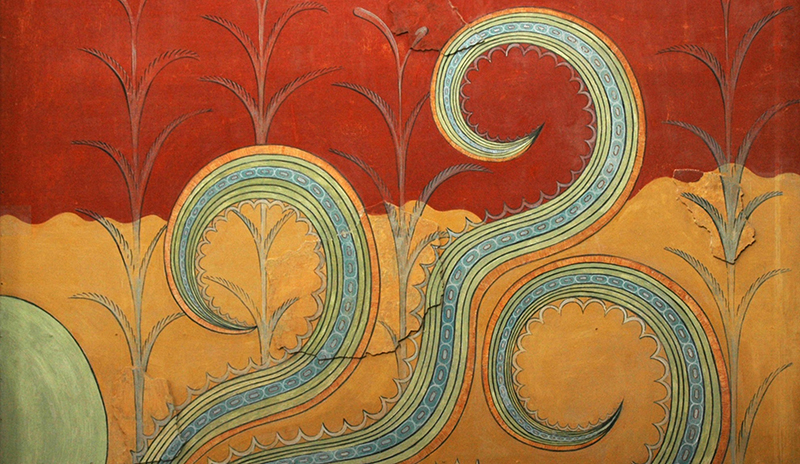
The columns, made of cypress trunks, were wider at the top than the base.
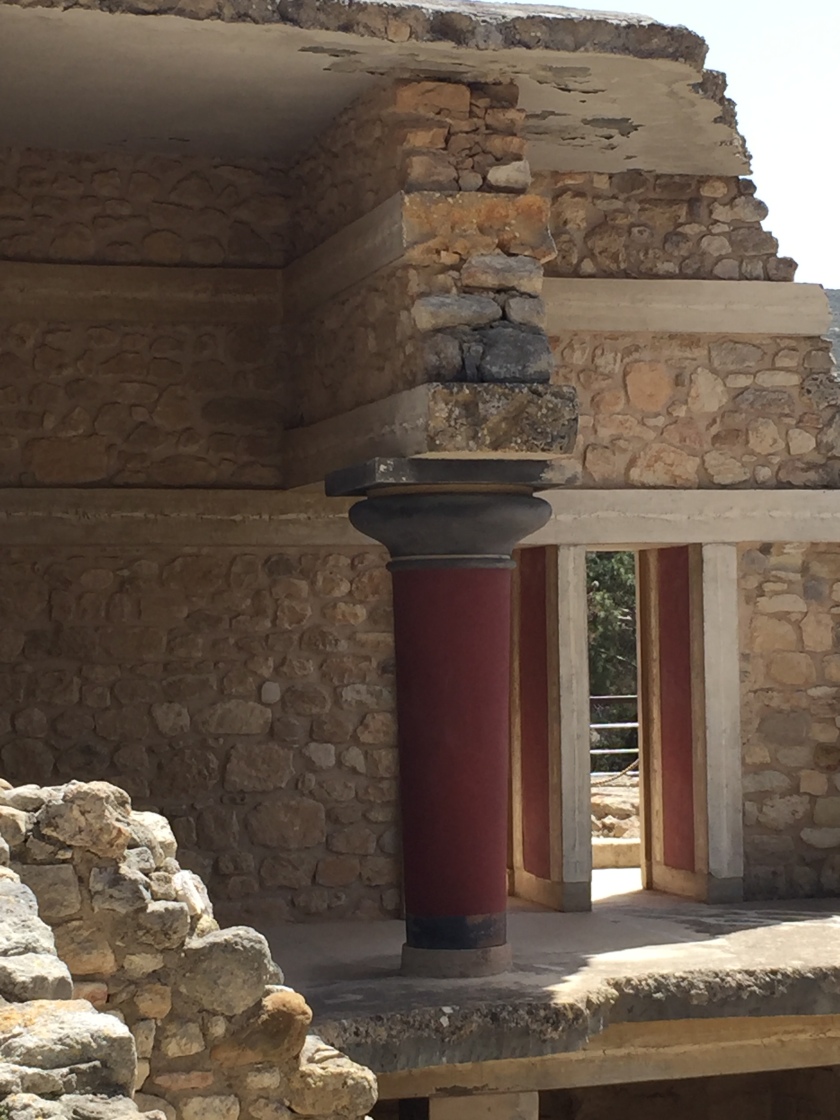
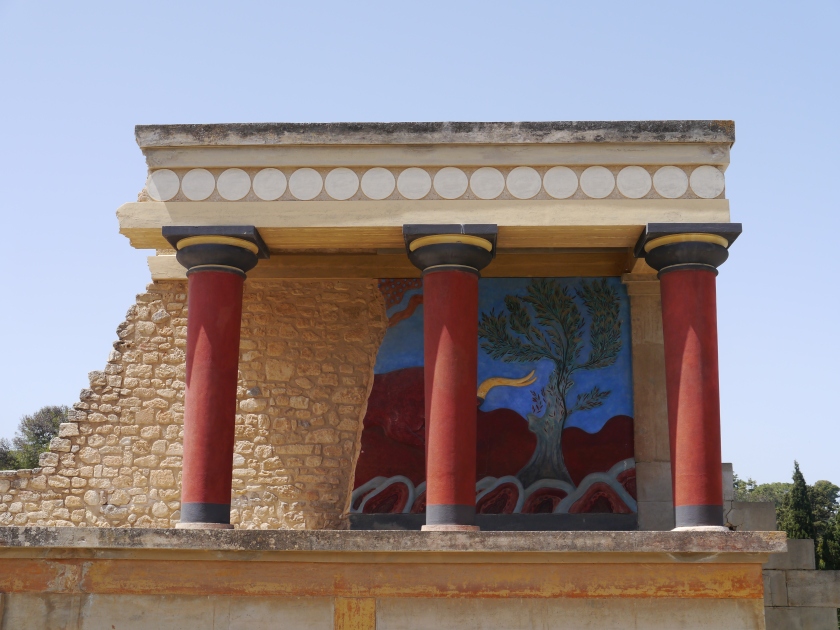
The appartment walls were decorated with wonderful murals.
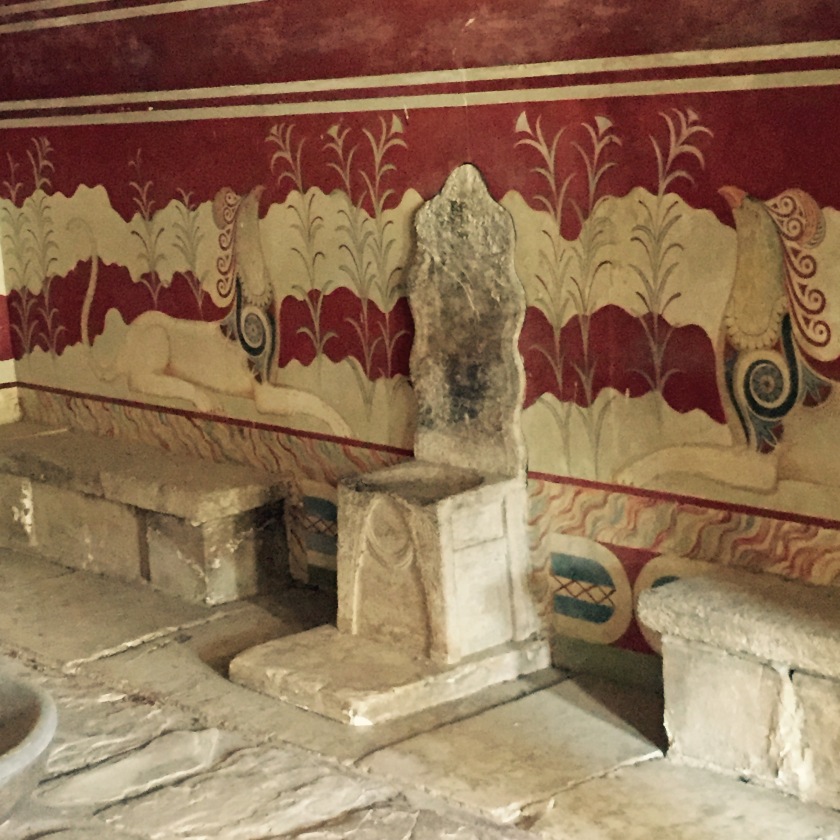
The Minoans had workshops which made delicate jewellery.
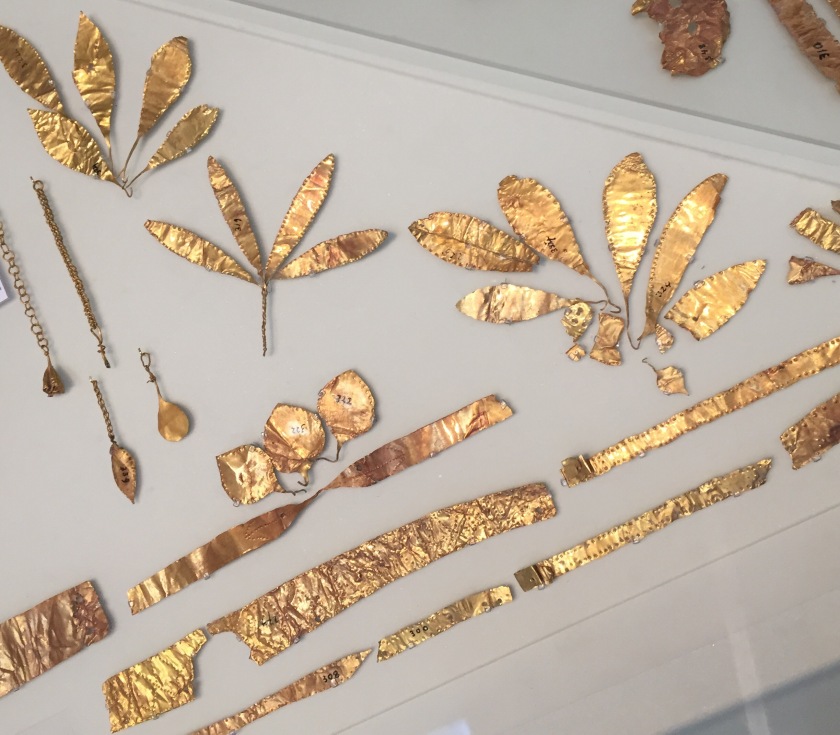
And even more delicate porcelain, known as Kamares vessels. (Καμαραϊκά αγγεία)
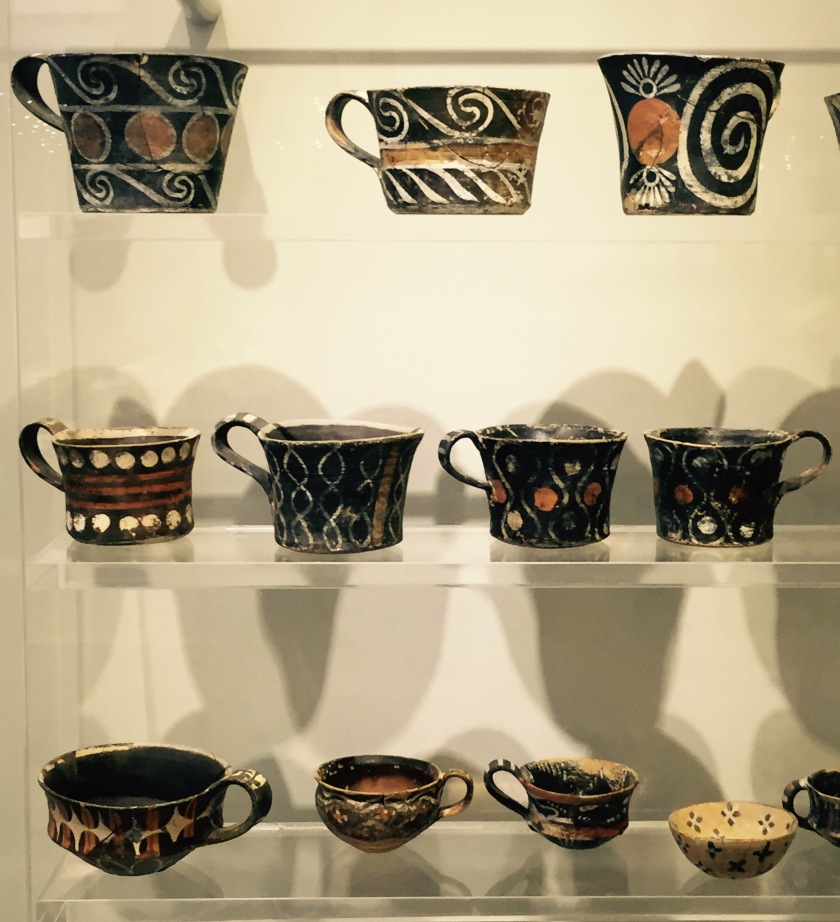
They had a theatre,
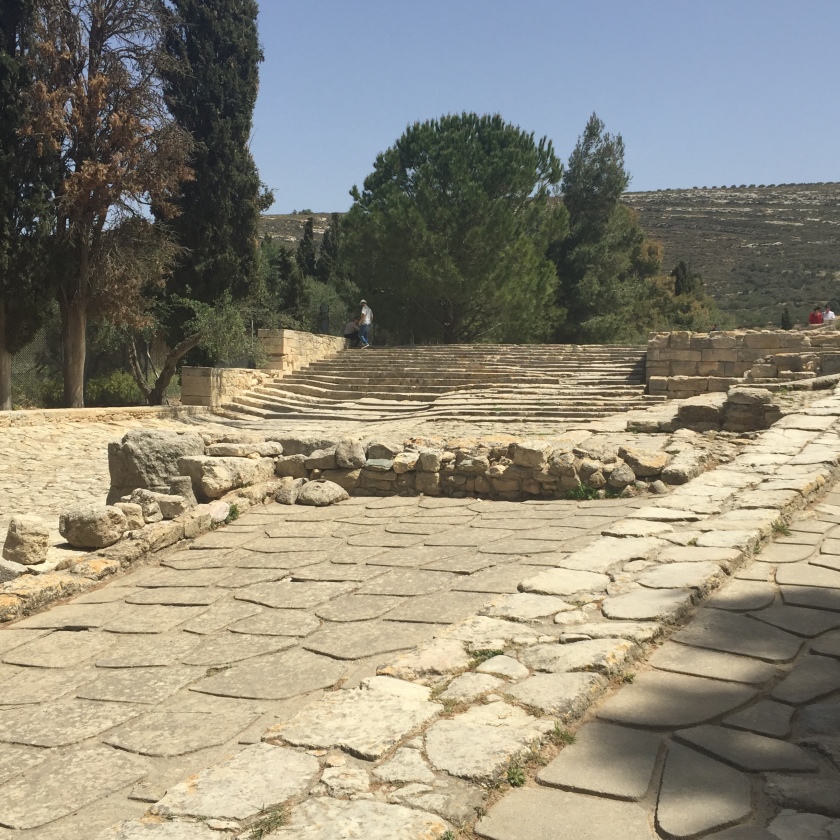
and a central courtyard where the famous bull games took place. These involved both boys and girls somersaulting over a bull, which was not killed at the end of the games (as in Spanish bullfights). It probably ended up being sacrificed to the gods, though.
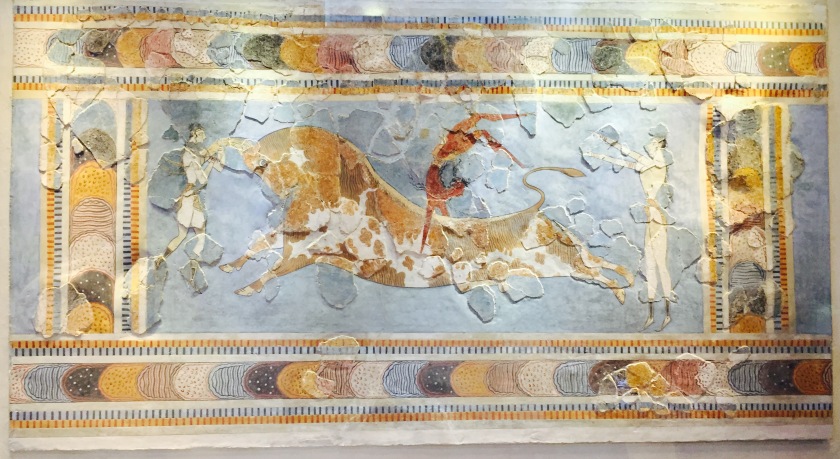
The Minoan palaces also had plumbing – running water and sewage – even on the top floors (something not seen again until the Romans, 2000 years later). Also the orientation of each room made for perfect ventilation; we visited on a hot day, and the temperature indoors was several degrees lower than outside.
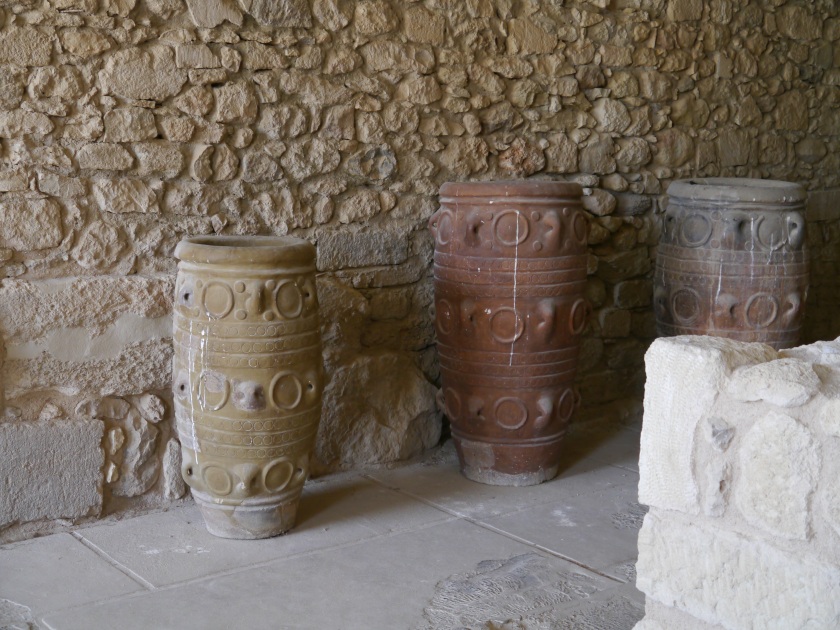
We continued with a visit to the Irakleion museum, which has been totally refurbished and contains all the important artifacts.
The bull was worshiped as a symbol of strength and thus portrayed in many ways.
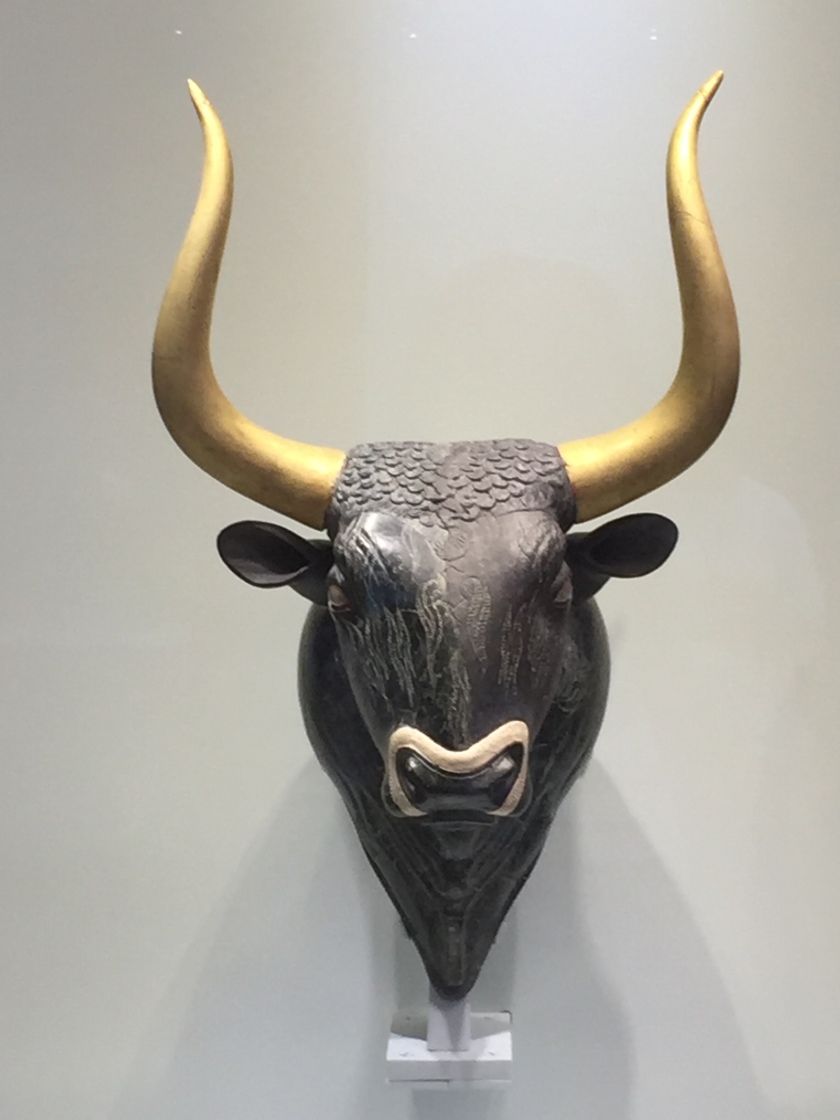
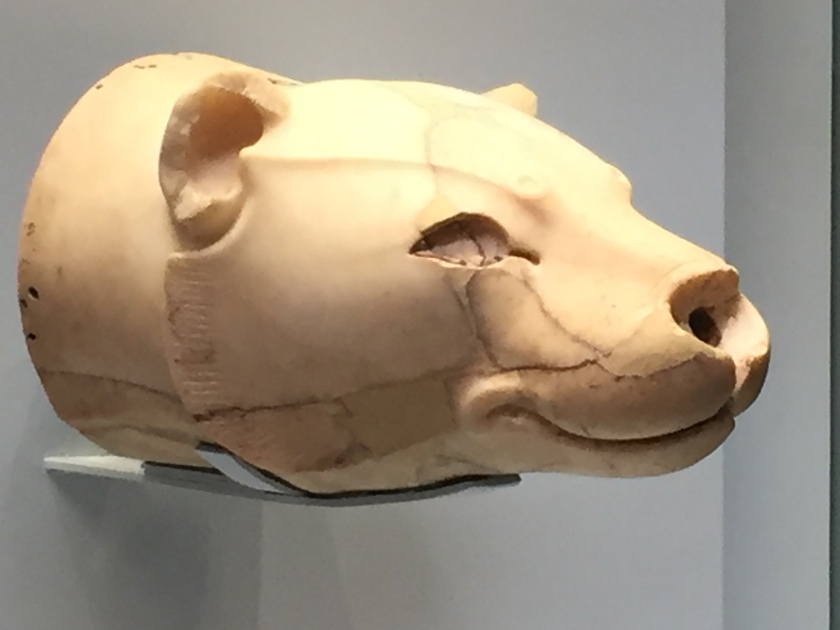
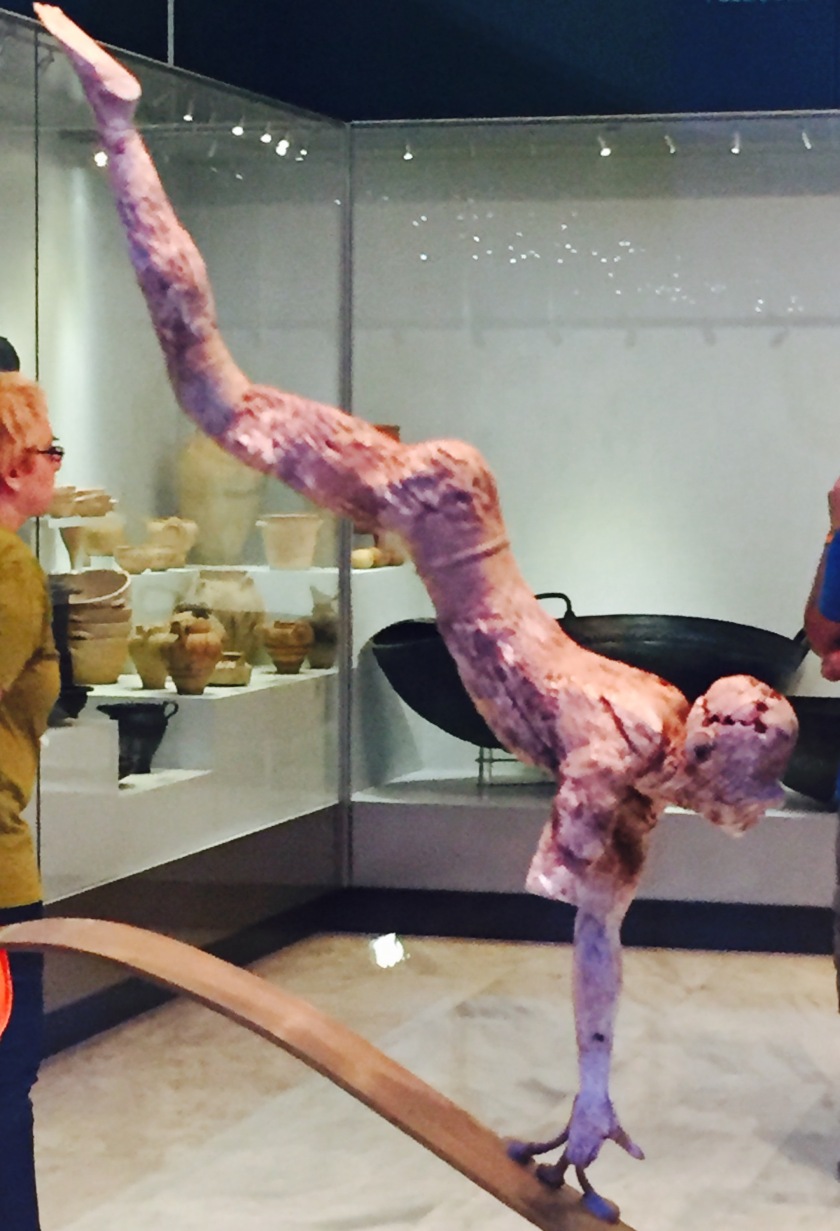
We finished the day with a cooling swim in the sea, and the next morning set off for Phaistos, and hour and a half away through lovely scenery. The mountains were covered with Cretan ebony, small bushes covered in pink flowers. They looked a little like overgrown thyme, but apparently their seeds produce very vivid black dye, used in ancient times and still today.
The palace of Phaistos is much smaller than Knossos (around 700 rooms), but still impressive, built on a lovely site overlooking fertile plains.
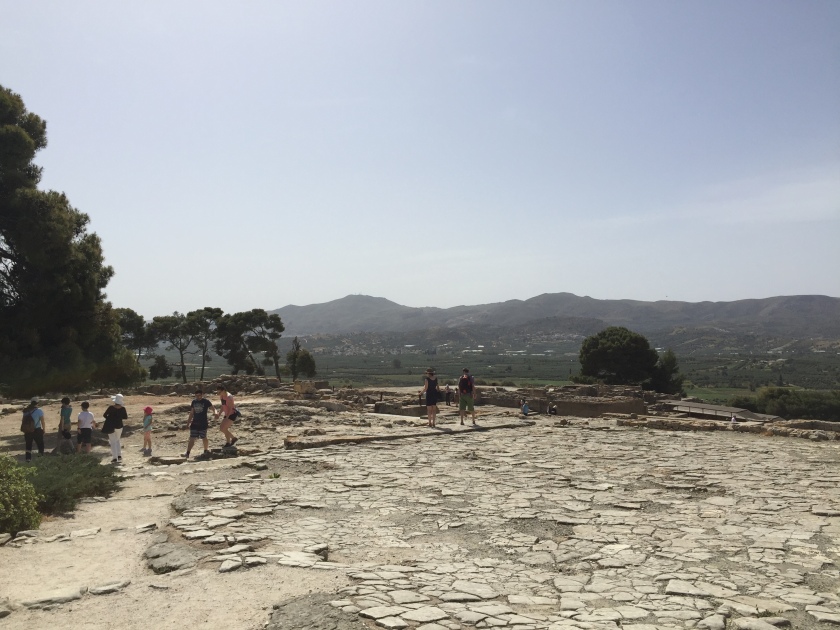
It faces north and thus also has superb ventilation, as well as plumbing and workshops. One of the trades first practiced there is that of metallurgy.
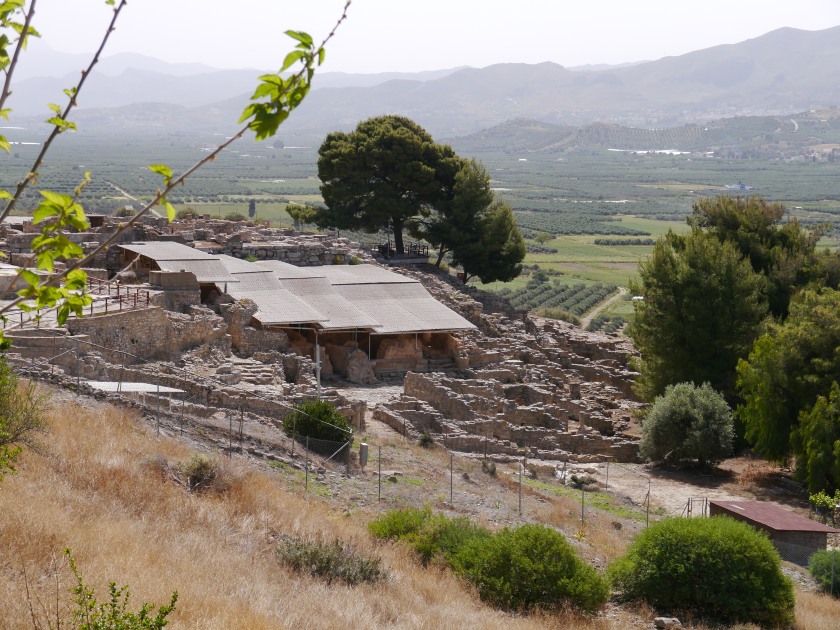
It also has a theatre,

And wide stairways.
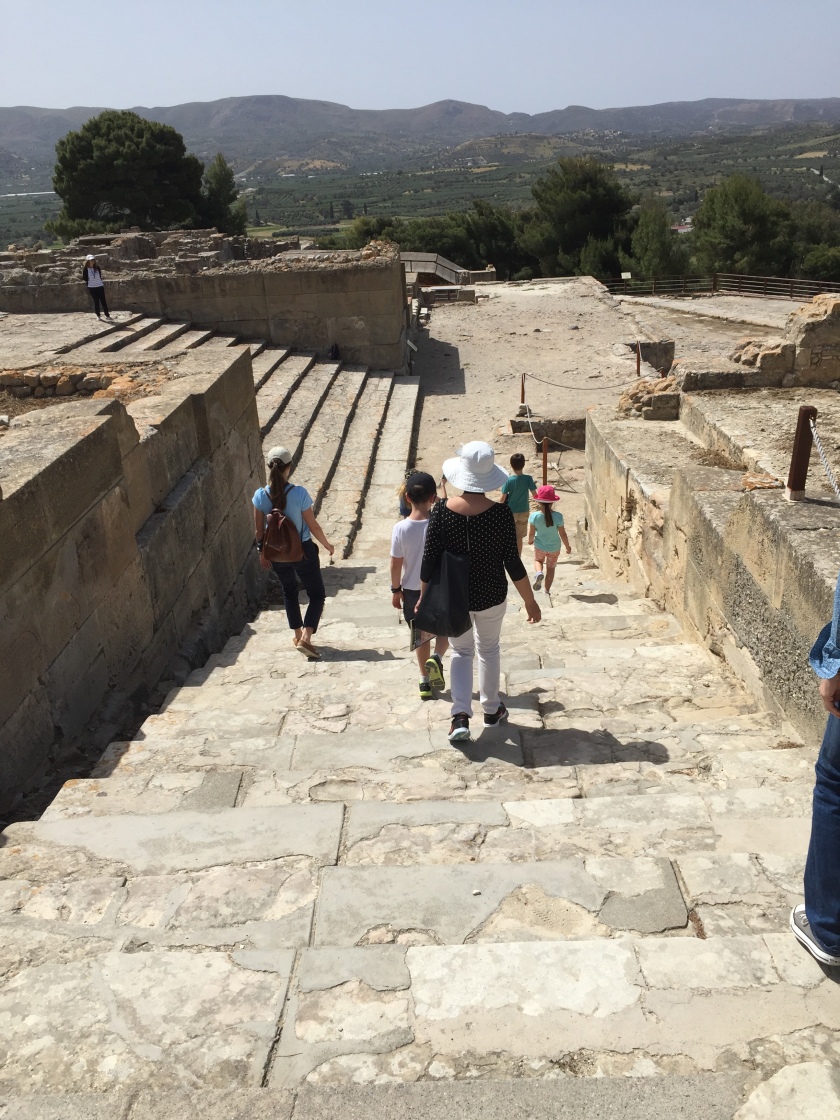
Feeling famished after our visit, we stopped off for lunch at a little taverna down the road. We were welcomed by a lone man who did not speak Greek well. Fearful it would take forever to get served, we made the kids all have the same thing. However, things started arriving on our table in a delicious sequence – salads of delicious tomato and cucumber, little spinach pies melting in the mouth, saganaki (grilled cheese), the most aromatic spaghetti bolognaise for the kids and, for the adults, a chicken tagine with saffron and prunes. I’d thought the man was Egyptian but he proved to be a Moroccan. Having finished serving, he sat down next to us for a chat and told us he’d been a cook on the ships, had stopped off in Crete on leave 30 years ago and stayed. But, he said, placing his hand on his heart, it was his mother who’d taught him to cook. She must have been one hell of a chef!
Having some time to spare before our flight, we stopped off at Gortyna, the site of a beautiful domeless Byzantine church
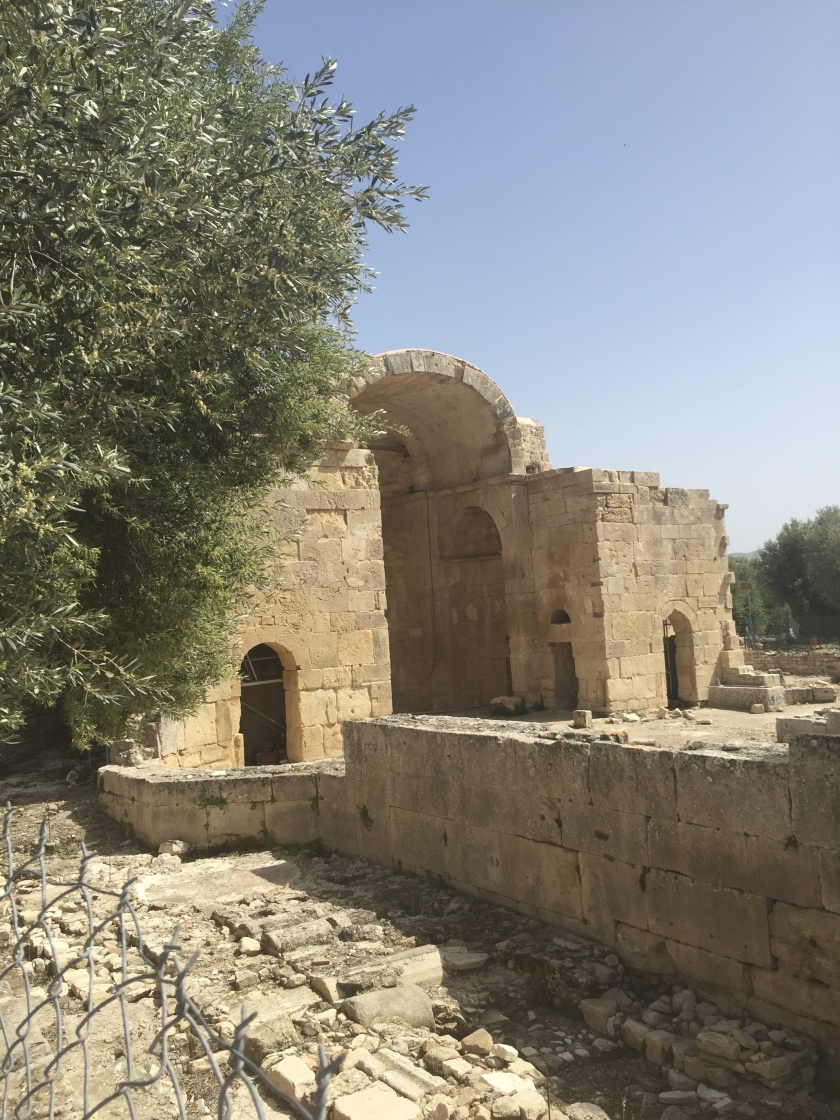
And a Roman Odeon
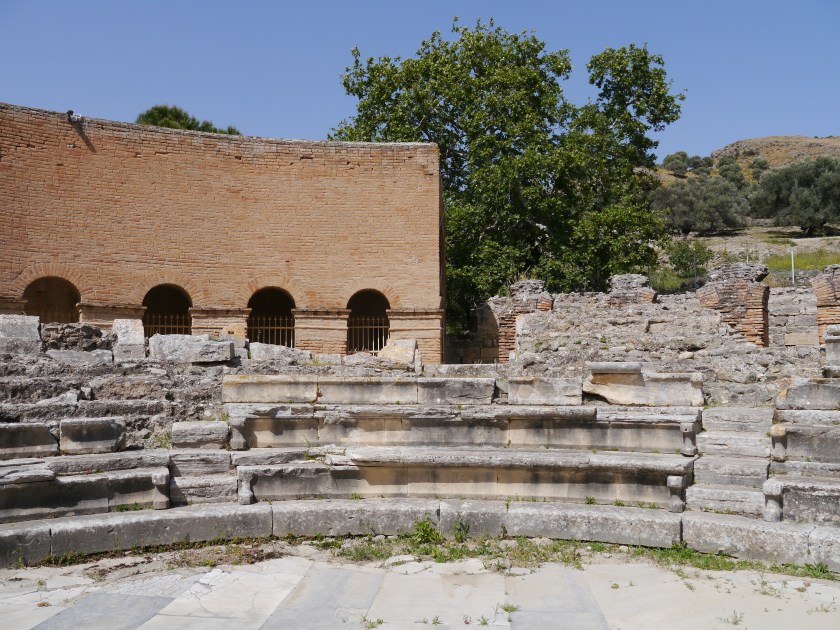
The surrounding land contained ancient olive trees, one of which was around 700 years old;
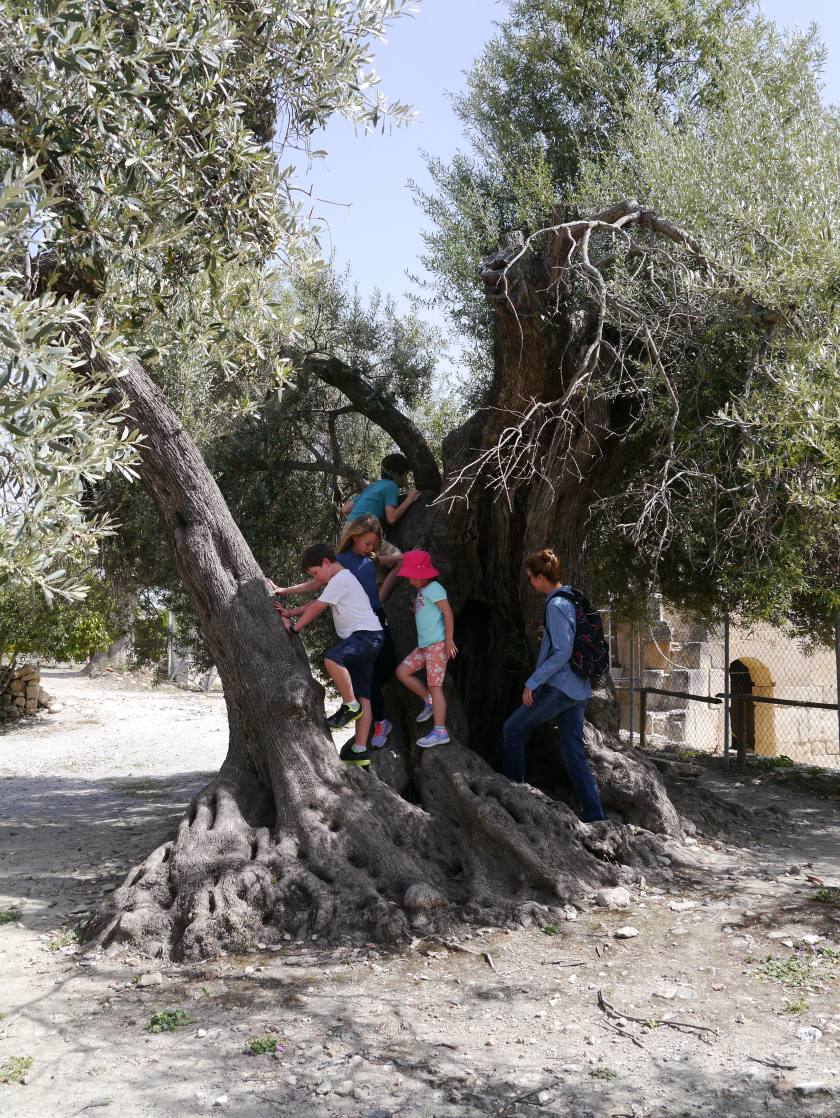
as well as the descendant of the plane tree under which the union was consummated between Zeus and Europa which would produce King Minos and his siblings, Radamanthes and Sarpedon.
The peculiarity of this tree is that it is the only plane tree that is not deciduous – it keeps its leaves in winter!
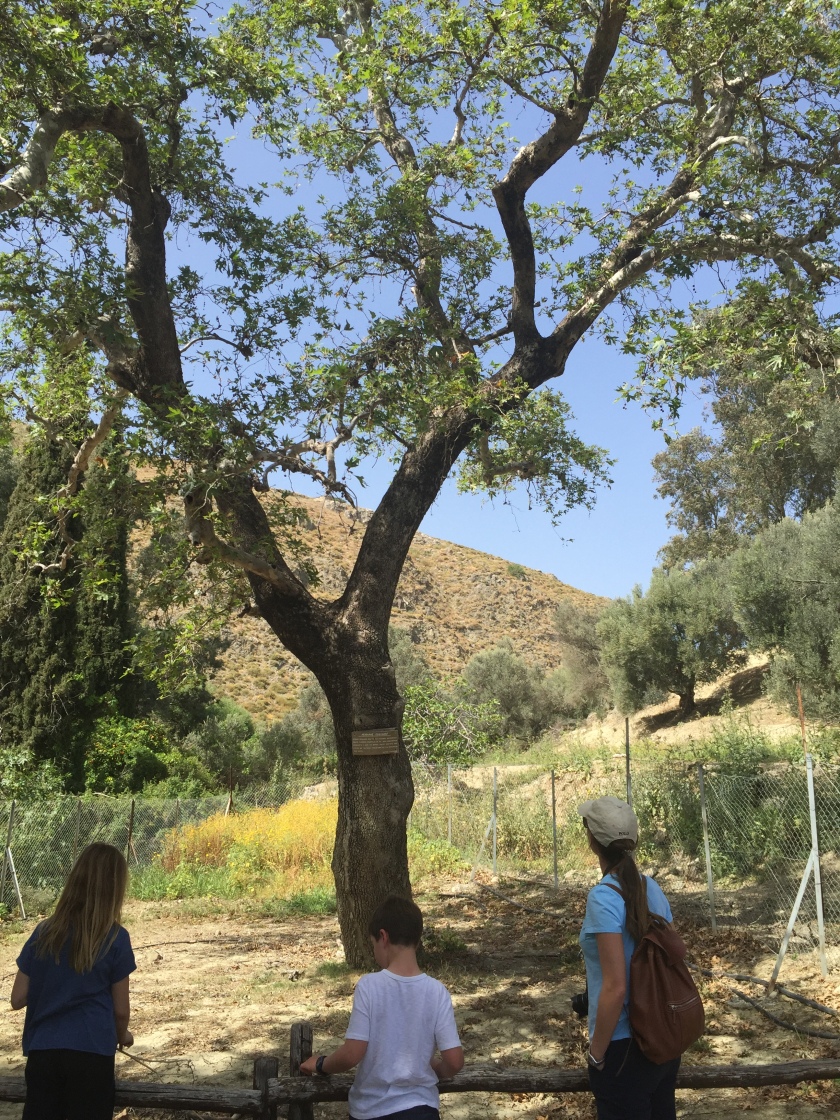
Obviously, this is just the description of a family trip. I’m no historian, so for anyone interested in finding out more about the Minoan civilization, I can recommend the excellent book written by Stylianos Alexiou.
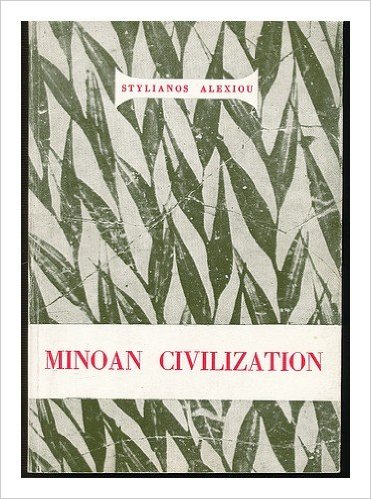


What a wonderful day! I thoroughly enjoyed the arm-chair tour! Now, I’m hungry though. 🙂
LikeLiked by 2 people
What a great trip, the place must have been amazing. Thanks for showing us around.
LikeLiked by 1 person
We have something similar here every summer called course landaises – young men summersault over cows – and the cows are not killed either. The cows do however get wise to the game and have to be retired when they become too dangerous.
LikeLiked by 3 people
Yes, a friend tried it with the ‘vachettes’. He said they were vicious!!
LikeLike
Lovely Post Marina-as you know my Paternal Roots are Crete; it is an amazing Island. Funny my Grandfather (Papou) name is Stylianos Hatzidakis! No doubt where my Great- and great-great Papou’s are laid to rest. RIP…Cheryl xx
LikeLiked by 2 people
I love Crete. I visited in 1988 and would love to go again. New Zealanders have a special affection for Crete as a result of WWII, but there’s something about the landscape and the people above and beyond that. Don’t ask me why. The people I was travelling with back then felt the same, but we couldn’t figure it out.
LikeLiked by 2 people
Well I’d LOVE to visit New Zealand, so it evens out!
LikeLiked by 1 person
I have a spare bedroom.
LikeLiked by 1 person
A wonderful tour, thank you, from one who will never get there!
LikeLiked by 1 person
I’m glad you enjoyed it!
LikeLiked by 1 person
What a fascinating tour!
LikeLiked by 1 person
So much history in the ruins and very fascinating! Those views are stunning!!
LikeLiked by 1 person
that is fascinating; i’d love to visit.
LikeLiked by 1 person
Do. Photographs can never do justice to this kind of thing. All these ancient sites have a special aura about them
LikeLiked by 2 people
Just fabulous
LikeLike
I really enjoyed my trip with you to Crete. I studied Minoan civilisation in undergraduate days and was fascinated. Glad your grandchildren had the opportunity to experience it with you. Great pictures too.
LikeLiked by 2 people
I visited Crete many years ago and would probably have gone to Knossos although I don’t recognise it now. Is the restoration fairly recent?
LikeLiked by 2 people
No, it’s not. Maybe you went to the other palaces…
LikeLiked by 1 person
Fascinating! I used to love Greek mythology as a child. It’s lovely to reconnect with some of those stories through your blog. Thank you!
LikeLiked by 3 people
Great photos!
LikeLiked by 1 person
How interesting! When I was little, I loved to read ancients greek myths. Those stories fascinated me. I would love to go and visit Crete.
LikeLiked by 2 people
Thank you sharing with us your lovely tour and the beautiful pictures…
LikeLike
I now know much about some of the facts behind the Greek myths i love so much. And I’m starved! I think I’d go there just to eat in that restaurant. It sounds like you had a lovely adventure with your grandchildren.
LikeLike
Thank you. Those places look amazing and the food sounds good as well.
LikeLiked by 1 person
It was! Glad you enjoyed it the post
LikeLiked by 1 person
It is a splendid family journey but more than ony that: you allow us to visit with you, and play guide with beautiful photos and comments; you reconnect us with Minoan civilisation, culture and myths. And you give references for further reading! This is a lot in one blog.
I have aways been fascinated by the modern ways according to which the Minoans lived. I wonder if this was for palaces only. And of course, the labyrinth has had a lasting power over the Westerners.
Difficult when you are a child to unravel the complex tangle of facts and myths in this culture!
Thank you for sharing with us this family moment.
Camille
xx
LikeLike
Beautiful pictures! I enjoyed reading about this. Love the jewellery and porcelain collection.
LikeLiked by 1 person
What a lovely and interesting post. Never been to Crete but you really made me want to visit. That restaurant sounded fantastic!
LikeLiked by 1 person
Knossos is a place I would absolutely love to see. I’m fascinated by the Minoans aesthetic sense too. Their artwork has a lightness and delicacy that seems surprisingly modern to me. 🙂
LikeLike
It is. Definitely worth a visit.
LikeLiked by 1 person
Fingers crossed I get there one day. 🙂
LikeLiked by 1 person
Fantastic photographs give me a real taste of the place. It’s history is amazing.
xxx Huge Hugs xxx
LikeLiked by 1 person
An amazing post Marina! Wow it would be great to visit but you have given us a great tour!
LikeLike
So glad you enjoyed it! X
LikeLiked by 1 person
I have not traveled and would love to see these things Marina!
LikeLiked by 1 person
You still might – it’s never too late!
LikeLiked by 1 person
so true!
LikeLiked by 1 person
Amazing!
It boggles my mind that Minoans and even the Romans had sewage and the UK has only had toilets in all houses for around a hundred years.
LikeLike
What a wonderful trip and opportunity for you and your kids to learn about such a rich culture. Your pictures are superb. Thanks so much for sharing with us. 🙂
LikeLiked by 1 person
I was on Crete in 2010 and went to experience the Minoan culture as well. Beautiful. If we think that we are living the most advanced culture, I suggest we think again…civilized cultures come and go. We live in circles, not along a straight line 🙂
LikeLike
Reblogged this on Letters from Athens and commented:
Since we are, for the moment, confined to barracks, I thought a Throwback Thursday was perfect for a spot of armchair traveling. Going back to old posts written in the same month of the year, this one is about a trip to Crete and the amazing Minoan civilization. Posted in April 2016.
LikeLike
Such an interesting photo essay, and most excellent experience for your Grandchildren. Thank you. All my best, stay safe.
LikeLike
Fascinating historical trip well photographed.
LikeLiked by 1 person
Thanks, Derrick!
LikeLiked by 1 person